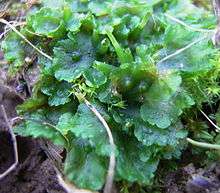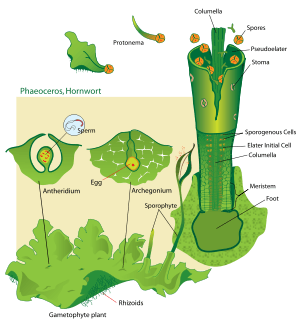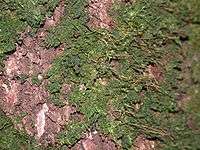Hornwort
Hornworts are a group of non-vascular plants constituting the division Anthocerotophyta. The common name refers to the elongated horn-like structure, which is the sporophyte. As in mosses and liverworts, the flattened, green plant body of a hornwort is the gametophyte plant.
| Hornworts | |
|---|---|
 | |
| Phaeoceros laevis (L.) Prosk. | |
| Scientific classification | |
| Kingdom: | Plantae |
| Clade: | Embryophytes |
| Division: | Anthocerotophyta Stotler & Stotl.-Crand., 1977[1] |
| Classes and orders | |
see Classification. | |
| Synonyms | |
|
Anthocerotae | |
Hornworts may be found worldwide, though they tend to grow only in places that are damp or humid. Some species grow in large numbers as tiny weeds in the soil of gardens and cultivated fields. Large tropical and sub-tropical species of Dendroceros may be found growing on the bark of trees.
The total number of species is still uncertain. While there are more than 300 published species names, the actual number could be as low as 100-150 species.[2]
Description
The plant body of a hornwort is a haploid gametophyte stage. This stage usually grows as a thin rosette or ribbon-like thallus between one and five centimeters in diameter. Each cell of the thallus usually contains just one chloroplast. In half of the roughly 200 hornwort species, this chloroplast is fused with other organelles to form a large pyrenoid that both enables more efficient photosynthesis and stores food. The pyrenoid is comprised predominantly of RuBisCO, the key enzyme in carbon fixation. By using inorganic carbon transporters and carbonic anhydrases, up to a 50-fold increase in CO2 levels can be achieved.[3] This particular feature is very unusual in land plants, unique to hornworts, but is common among algae.
Many hornworts develop internal mucilage-filled cavities or canals when groups of cells break down. They will secrete hormogonium-inducing factors (HIF) that stimulate nearby, free-living photosynthetic cyanobacteria, especially species of Nostoc, to invade and colonize these cavities.[4] Such colonies of bacteria growing inside the thallus give the hornwort a distinctive blue-green color. There may also be small slime pores on the underside of the thallus. These pores superficially resemble the stomata of other plants.
The horn-shaped sporophyte grows from an archegonium embedded deep in the gametophyte. The sporophyte of a hornwort is unusual in that it grows from a meristem near its base, instead of from its tip the way other plants do. Unlike liverworts, most hornworts have true stomata on their sporophyte as mosses do. The exceptions are the genera Notothylas and Megaceros, which do not have stomata. The sporophyte of most hornworts are also photosynthetic, which is not the case with liverworts.[5]
When the sporophyte is mature, it has a multicellular outer layer, a central rod-like columella running up the center, and a layer of tissue in between that produces spores and pseudo-elaters. The pseudo-elaters are multi-cellular, unlike the elaters of liverworts. They have helical thickenings that change shape in response to drying out; they twist and thereby help to disperse the spores. Hornwort spores are relatively large for bryophytes, measuring between 30 and 80 µm in diameter or more. The spores are polar, usually with a distinctive Y-shaped tri-radiate ridge on the proximal surface, and with a distal surface ornamented with bumps or spines
Life cycle
The life of a hornwort starts from a haploid spore. In most species, there is a single cell inside the spore, and a slender extension of this cell called the germ tube germinates from the proximal side of the spore.[6] The tip of the germ tube divides to form an octant (solid geometry) of cells, and the first rhizoid grows as an extension of the original germ cell. The tip continues to divide new cells, which produces a thalloid protonema. By contrast, species of the family Dendrocerotaceae may begin dividing within the spore, becoming multicellular and even photosynthetic before the spore germinates.[6] In either case, the protonema is a transitory stage in the life of a hornwort.

From the protonema grows the adult gametophyte, which is the persistent and independent stage in the life cycle. This stage usually grows as a thin rosette or ribbon-like thallus between one and five centimeters in diameter, and several layers of cells in thickness. It is green or yellow-green from the chlorophyll in its cells, or bluish-green when colonies of cyanobacteria grow inside the plant.
When the gametophyte has grown to its adult size, it produces the sex organs of the hornwort. Most plants are monoecious, with both sex organs on the same plant, but some plants (even within the same species) are dioecious, with separate male and female gametophytes. The female organs are known as archegonia (singular archegonium) and the male organs are known as antheridia (singular antheridium). Both kinds of organs develop just below the surface of the plant and are only later exposed by disintegration of the overlying cells.
The biflagellate sperm must swim from the antheridia, or else be splashed to the archegonia. When this happens, the sperm and egg cell fuse to form a zygote, the cell from which the sporophyte stage of the life cycle will develop. Unlike all other bryophytes, the first cell division of the zygote is longitudinal. Further divisions produce three basic regions of the sporophyte.
At the bottom of the sporophyte (closest to the interior of the gametophyte), is a foot. This is a globular group of cells that receives nutrients from the parent gametophyte, on which the sporophyte will spend its entire existence. In the middle of the sporophyte (just above the foot), is a meristem that will continue to divide and produce new cells for the third region. This third region is the capsule. Both the central and surface cells of the capsule are sterile, but between them is a layer of cells that will divide to produce pseudo-elaters and spores. These are released from the capsule when it splits lengthwise from the tip.
Evolutionary history
While the fossil record of crown group hornworts only begins in the upper Cretaceous, the lower Devonian Horneophyton may represent a stem group to the clade, as it possesses a sporangium with central columella not attached at the roof.[7] However, the same form of columella is also characteristic of basal moss groups, such as the Sphagnopsida and Andreaeopsida, and has been interpreted as a character common to all early land plants with stomata.[8] Chromosome-scale genome sequencing of three hornwort species corroborate that stomata evolved only once during land plant evolution. It also shows that the three groups of bryophytes share a common ancestor that branched off from the other landplants early in evolution, and that liverworts and mosses are more closely related to each other than with hornworts.[9]
Hornworts are unique in having a gene called LCIB, which is not found in any other known land plants but occurs in some species of algae. It allows them to concentrate carbon dioxide inside their chloroplasts, making the production of sugar more efficient.[10]
Classification

Hornworts were traditionally considered a class within the division Bryophyta (bryophytes). However, it now appears that this former division is paraphyletic, so the hornworts are now given their own division, Anthocerotophyta (sometimes misspelled Anthocerophyta). The division Bryophyta is now restricted to include only mosses.
Traditionally, there is a single class of hornworts, called Anthocerotopsida, or older Anthocerotae. More recently, a second class Leiosporocertotopsida has been segregated for the singularly unusual species Leiosporoceros dussii. All other hornworts remain in the class Anthocerotopsida. These two classes are divided further into five orders, each containing a single family.
Among land plants, hornworts are one of the earliest-diverging lineages of the early land plant ancestors [11]; cladistic analysis implies that the group originated prior to the Devonian, around the same time as the mosses and liverworts. There are about 200 species known, but new species are still being discovered. The number and names of genera are a current matter of investigation, and several competing classification schemes have been published since 1988.
Structural features that have been used in the classification of hornworts include: the anatomy of chloroplasts and their numbers within cells, the presence of a pyrenoid, the numbers of antheridia within androecia, and the arrangement of jacket cells of the antheridia.[12]
Phylogeny
Recent studies of molecular, ultrastructural, and morphological data have yielded a new classification of hornworts.[13]
order Leiosporocerotales
order Anthocerotales
order Notothyladales
order Phymatocerotales
order Dendrocerotales
|
| |||||||||||||||||||||||||||||||||||||||||||||||||||||||||||||||||||||||||||
| The current phylogeny and composition of the Anthocerotophyta.[13][14] | ||||||||||||||||||||||||||||||||||||||||||||||||||||||||||||||||||||||||||||
See also
References
- Stotler, Raymond E.; Barbara J. Candall-Stotler (1977). "A checklist of the liverworts and hornworts of North America". The Bryologist. American Bryological and Lichenological Society. 80 (3): 405–428. doi:10.2307/3242017. JSTOR 3242017.
- What is a hornwort? - Australian National Botanic Gardens
- Meyer, Moritz T.; McCormick, Alistair J.; Griffiths, Howard (2016). "Will an algal CO2-concentrating mechanism work in higher plants?". Current Opinion in Plant Biology. 31: 181–188. doi:10.1016/j.pbi.2016.04.009. PMID 27194106.
- Meeks, JC (1998). "Symbiosis between nitrogen-fixing cyanobacteria and plants". BioScience. 48 (4): 266–276. doi:10.2307/1313353. JSTOR 1313353.
- "Mosses, Liverworts, and Hornworts" (PDF). Archived from the original (PDF) on 2017-10-13. Retrieved 2015-10-24.
- Chopra, R. N.; Kumra, P. K. (1988). Biology of Bryophytes. New York: John Wiley & Sons. ISBN 0-470-21359-0.
- Qiu, Y.L.; Li, L.; Wang, B.; Chen, Z.; Knoop, V.; Groth-malonek, M.; Dombrovska, O.; Lee, J.; Kent, L.; Rest, J.; et al. (2006). "The deepest divergences in land plants inferred from phylogenomic evidence". Proceedings of the National Academy of Sciences. 103 (42): 15511–6. Bibcode:2006PNAS..10315511Q. doi:10.1073/pnas.0603335103. PMC 1622854. PMID 17030812.
- Kenrick, Paul; Peter R. Crane (1997). The Origin and Early Diversification of Land Plants: A Cladistic Study. Washington, D. C.: Smithsonian Institution Press. pp. 55–56. ISBN 1-56098-730-8.
- Li, F-W.; Nishiyama, T.; Waller, M.; et, al. (2020). "Anthoceros genomes illuminate the origin of land plants and the unique biology of hornworts". Nature Plants. 6 (3): 259–272. doi:10.1038/s41477-020-0618-2.
- Ancient hornwort genomes could lead to crop improvement
- Li, F-W.; Nishiyama, T.; Waller, M.; et, al. (2020). "Anthoceros genomes illuminate the origin of land plants and the unique biology of hornworts". Nature Plants. 6 (3): 259–272. doi:10.1038/s41477-020-0618-2.
- D. Christine Cargill, Karen S. Renzaglia, Juan Carlos Villarreal, and R. Joel Duff (2005), "Generic concepts within hornworts: Historical review, contemporary insights and future directions", Australian Systematic Botany, 18: 7–16, doi:10.1071/sb04012CS1 maint: uses authors parameter (link)
- Duff, R. Joel; Juan Carlos Villarreal; D. Christine Cargill; Karen S. Renzaglia (2007). "Progress and challenges toward a phylogeny and classification of the hornworts". The Bryologist. 110 (2): 214–243. doi:10.1639/0007-2745(2007)110[214:PACTDA]2.0.CO;2.
- Villareal, J. C.; Cargill, D. C.; Hagborg, A.; Söderström, L.; Renzaglia, K. S. (2010). "A synthesis of hornwort diversity: Patterns, causes and future work" (PDF). Phytotaxa. 9: 150–166. doi:10.11646/phytotaxa.9.1.8.
- Grolle, Riclef (1983). "Nomina generica Hepaticarum; references, types and synonymies". Acta Botanica Fennica. 121: 1–62.
- Hasegawa, J. (1994). "New classification of Anthocerotae". Journal of the Hattori Botanical Laboratory. 76: 21–34.
- Renzaglia, Karen S. (1978). "A comparative morphology and developmental anatomy of the Anthocerotophyta". Journal of the Hattori Botanical Laboratory. 44: 31–90.
- Renzaglia, Karen S. & Vaughn, Kevin C. (2000). Anatomy, development, and classification of hornworts. In A. Jonathan Shaw & Bernard Goffinet (Eds.), Bryophyte Biology, pp. 1–20. Cambridge: Cambridge University Press. ISBN 0-521-66097-1.
- Schofield, W. B. (1985). Introduction to Bryology. New York: Macmillan.
- Schuster, Rudolf M. (1992). The Hepaticae and Anthocerotae of North America, East of the Hundredth Meridian. VI. Chicago: Field Museum of Natural History.
- Smith, Gilbert M. (1938). Cryptogamic Botany, Volume II: Bryophytes and Pteridophytes. New York: McGraw-Hill Book Company.
- Watson, E. V. (1971). The Structure and Life of Bryophytes (3rd ed.). London: Hutchinson University Library. ISBN 0-09-109301-5.